It’s a glorious autumn morning on Brier Island, Nova Scotia, with birdsong in the air and the sun glinting off the rips of Grand Passage. Weathered clapboard and shingled houses line the island’s two principal streets, and chubby workboats—built for lobstering, mostly—jam the protected harbor, where wharves loom more than 20 feet above low tide.
Grand Passage appears almost empty on this day, except for the car ferry yo-yoing back and forth between Brier Island and Long Island, its two 400-horsepower engines roaring. But as I come around a bend, I spy a sleek yellow-and-white vessel, not half a mile from shore, pinned smack in the middle of the notoriously swift current. Though the craft has three narrow hulls, and what look like four giant propellers, it’s not a boat. It is a power plant capable of producing nearly 280 kilowatts of carbon-free electricity.
I hurry down to the harbor to meet Jason Hayman and Jason Clarkson, who work for Sustainable Marine Energy (SME), the Scotland-based company that developed this nifty device. We board their workboat, SMEagol, named after the deranged Hobbit, and head out into the current. I ask Hayman about the trimaran’s name—Plat-I, or “plat-eye.”
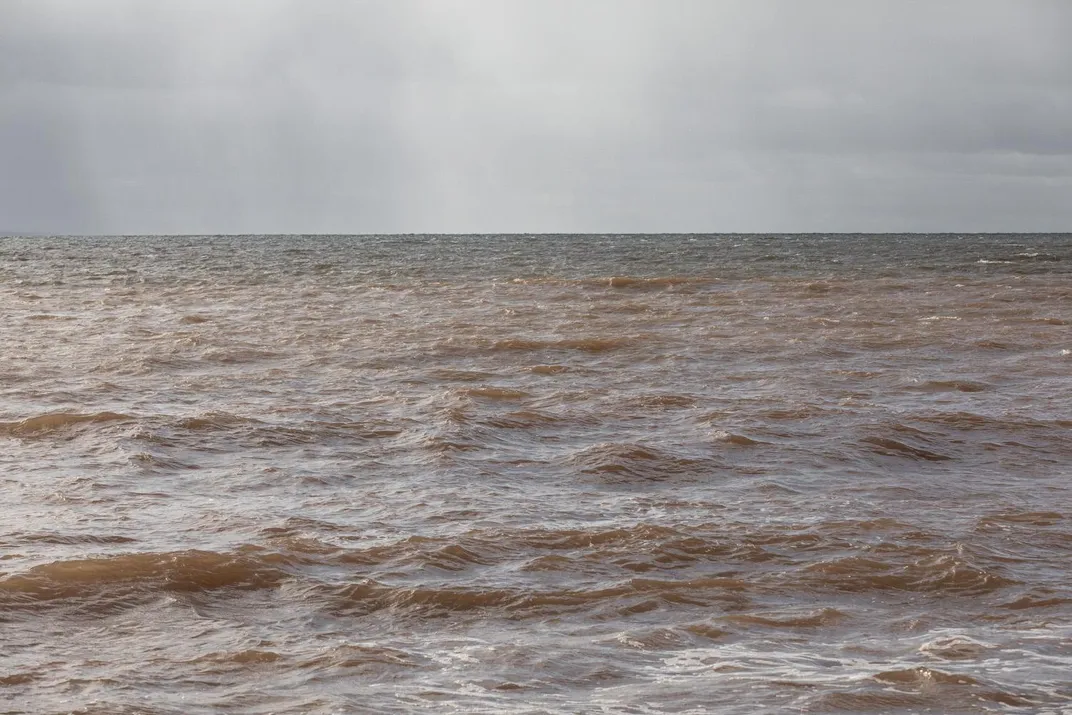
“We’re engineers,” he says, laughing. “‘Plat’ stands for platform, and ‘I’ is for inshore, meaning the device will be moored in sheltered island sites or coastal passages.” (The Plat-I’s predecessor was the Plat-0, for “offshore,” but the development team preferred to pronounce it like the Greek philosopher.)
We tie up to the Plat, then pick our way, clinging to a skinny lifeline, across its 88-foot-long crossbeam—a metal catwalk. “When there’s a little bit of a swell it can really mess with your head,” Hayman says.
Along the craft’s stern are four rotors, two barely visible in the water and two pivoted, for inspection purposes, toward the sky. At the Plat-I’s slender bow, stout cables tether the craft, through a mooring turret, to the seabed, allowing it to pivot on the tide, generating energy on both ebb and flow. “We survived the 140-kilometer winds of Hurricane Dorian,” Hayman says, in a tone suggesting that outcome wasn’t guaranteed.
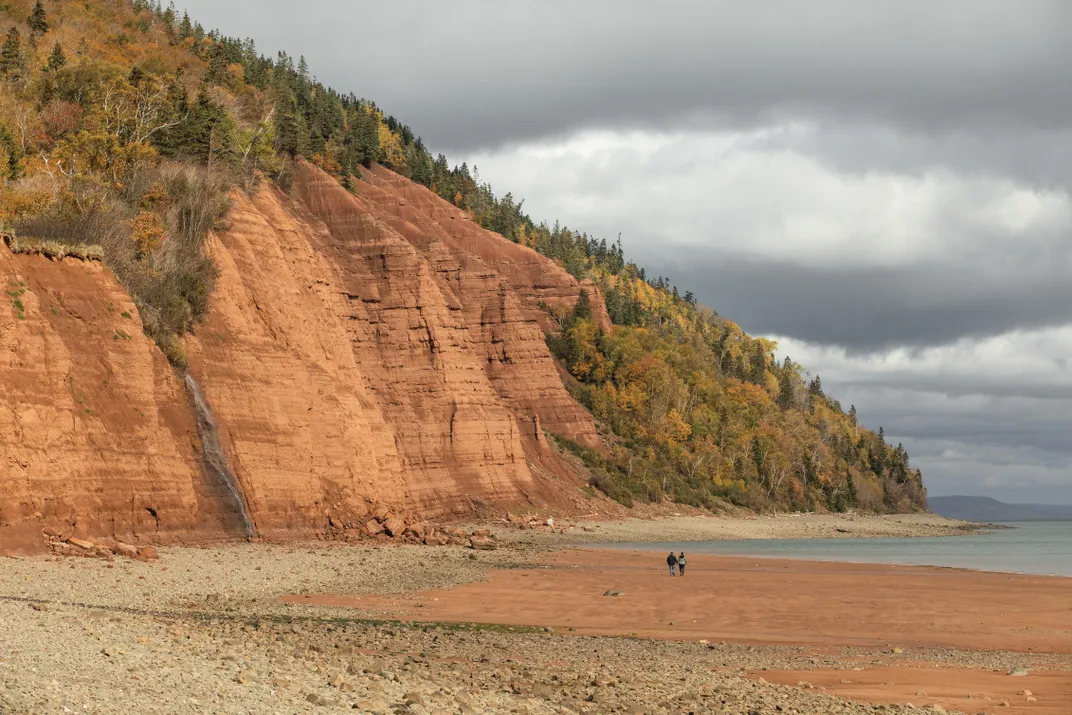
Crowded into a shipping container perched on the Plat’s center hull, we gaze at video monitors that show the underwater rotors, and Hayman opens three steel cabinets to reveal inverters, transformers and other electronics gear that, using a computer program the team calls its “secret sauce,” processes the water-generated electrical current to match the 60-hertz heartbeat of the local power grid. Apparently, any fool can produce electricity; making it usable is another matter entirely.
Sometime this summer, Hayman plans to flip a switch that will send juice generated by the device into the Digby Neck grid, displacing a chunk of the coal that provides about half of Nova Scotia’s energy. At that moment this unprepossessing rig, which from a distance looks like a dismasted trimaran awaiting restoration, will become the only operational floating tidal energy plant in North America.
Tidal energy is one of the greatest untapped renewable sources on the planet. In the United States, with thousands of miles of coastline, developing just 5 percent of tidal energy’s “identified technical resource potential,” says the Department of Energy, would generate 12.5 terawatt hours per year.* That’s enough to power slightly more than 1.1 million typical U.S. homes. But if tidal power evolves the way wind has, that number will likely rise. Over the decades, better designs have allowed wind turbines to generate, economically, in ever less-windy places. Tidal turbines, too, could eventually be placed in ever less-speedy currents. The market, says Levi Kilcher, of the National Renewable Energy Laboratory, “will end up being much larger than we’ve identified so far.”
Hydropower for the 21st Century
Renewable. Nonpolluting. It works in the dark, unlike solar power. And in a calm, unlike wind power. SME's floating tidal power station is gearing up to go online in Nova Scotia.
The Plat-I may seem like a tiny part of this energy revolution, an obscure project in a remote spot, but it may be just what the future requires: a simple and replicable energy source, tailored to the local environment, with batteries or other energy-storage systems to keep the power flowing during slack tides. After all, around 40 percent of the U.S. population lives in counties along the coast, and tidal devices could also be used in rivers.
Before Hayman’s company can start churning out Plat replicants, though, he must first overcome a monstrous challenge: operating his technology 140 miles to the northeast, in the funnel-shaped Bay of Fundy, which has the world’s largest tidal range—54 feet. Through the bay passes, twice daily, more than four times the estimated combined flow of every river on earth. That huge mass of water can move at more than ten miles an hour and has the potential to generate 50,000 megawatts, which is by some estimates enough to power 15 million homes. The Bay of Fundy is the ultimate test for any ocean-energy entrepreneur, and for a century inventors have been experimenting in its treacherous waters. But the bay is littered with disasters.
* * *
Hayman, 43, came to tidal power in the roundabout way of a sailor. Born in New Zealand to a mother who owned a travel agency and a father who researched dairy cow genetics, Hayman started messing around with boats early: In the summertime, his parents parked him at a local sailing club. He left college as a freshman when his uncle asked him to deliver a sailboat partway up the east coast of New Zealand’s North Island. “After that I was hooked,” Hayman says.
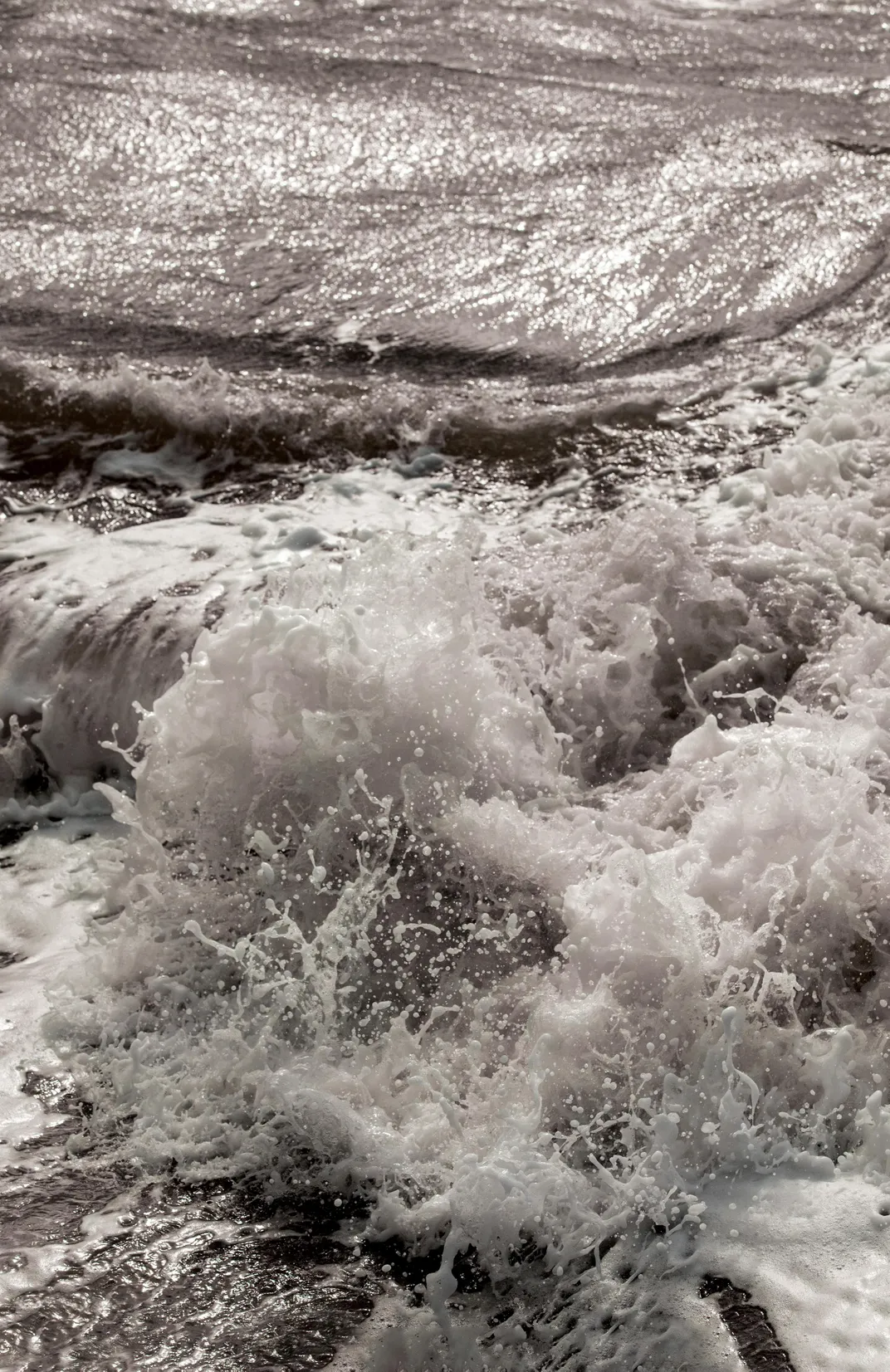
He worked on boats all over the world, including Antarctica. He developed and built racing boats in the Bahamas, where he also converted America’s Cup yachts to racing charters and operated a ferry business. But he realized that if he didn’t want to spend his entire life sanding fiberglass and humping sails up and down decks, he needed a college degree. At age 25, Hayman went ashore in England to study naval architecture at Newcastle University, then earned a master’s in engineering for sustainable development at the University of Cambridge. Soon he was working on floating production tankers, designing heavy-lifting equipment for the oil and gas industry, and doing marine salvage.
“Things that float need a naval architect,” Hayman says. One calls in a naval architect to safely lower large objects to the seabed, and to lift foundered vessels without breaking them up, he explains. In 2011, Hayman found himself in a helicopter speeding over the Borneo rainforest. He’d been dispatched to the region to extract a cargo ship grounded off Samarinda. A horrifying glimpse out the helicopter window changed the course of his life. “I saw thousands of acres of bulldozed tropical rainforest, and I asked the pilot what was going on,” Hayman recalls. “He said they’d been extracting coal from the area for five years. And I thought, Wow, that’s so much destruction in such a short amount of time.” Coal filled the hold of the ship he was about to rescue.
Wouldn’t it be better, he thought, to generate carbon-free energy from the movement of the sea than to dig it from the earth? One could avoid both the dangerous transport of fossil fuels and the outsize environmental impacts of extracting as well as burning them. “People are fixated on greenhouse gas emissions,” Hayman says, referring to the back end of a linear process. “But they are unaware of what it takes to generate energy up front.” After resurrecting the ship in Borneo, Hayman devoted himself to generating power from tides.
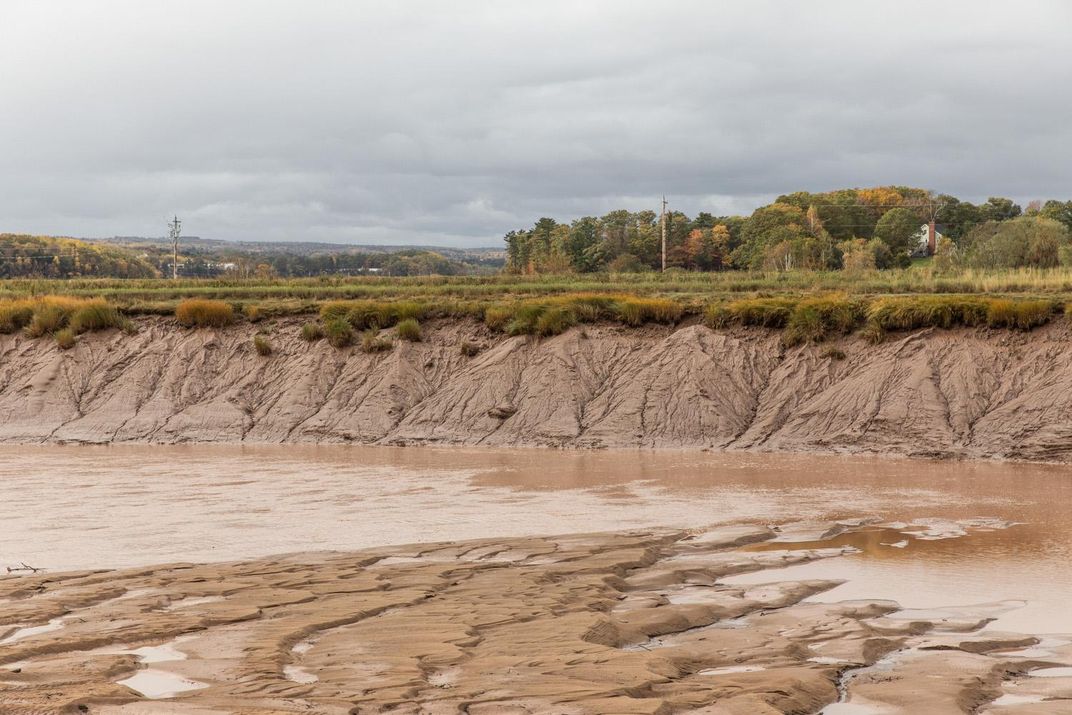
Most of us understand, on a basic level, that tides rise and fall in response to the Moon and the Sun’s gravitational pull on the oceans. But the nuances of tides are fantastically complex, and they remain slightly mysterious even to the learned. Tidal idiosyncrasies abound: Some places, like the Gulf of Mexico, see one high tide a day, instead of the more usual two, while others see four. As Jonathan White notes in his excellent Tides: The Science and Spirit of the Ocean, astronomers know exactly how celestial bodies affect tides, but what actually happens to water down here on earth “is unimaginably messy. Scientists are still working it out.”
All told, some 400 different variables are involved in creating the tides, but you don’t have to account for each and every one to appreciate that harnessing energy from this perpetual motion machine is an extremely good idea. The resource is clean, inexhaustible and, to an extent that even solar and wind are not, highly predictable.
Humans have derived power from the ocean for more than a millennium, trapping high tides in mill ponds behind dams, then releasing the flow at low tide through sluiceways directed at the paddles of waterwheels. The motion generated enough force to turn grinding stones or other mechanical devices. The first tidal mill in North America was built in 1607, in Annapolis Royal, Nova Scotia, some 60 miles from Grand Passage. Tidal mills were common throughout the province and the eastern U.S. in the 18th and 19th centuries, but it was in the 20th century that the Bay of Fundy became tidal engineering’s crucible of experimentation.
* * *
In 1915, Ralph Clarkson, an engineering professor at Nova Scotia’s Acadia University, prototyped a tidal-power generator with four pumps, powered by a horizontal waterwheel, that lifted water 335 feet into two tanks atop the Cape Split headland. The stored water ran down a tube to a conventional hydroelectric turbine at the base of the cliffs. The scheme attracted investors, but in 1920 a fire destroyed all of Clarkson’s equipment. The project never recovered.
Not long after that, Dexter Cooper, a hydraulic engineer in Maine, drew up plans for three dams, spanning a total of more than 7,000 feet, that would trap high tides in Passamaquoddy Bay, creating an upper pool that spread over 100 square miles. Upon release into the lower pool of Cobscook Bay, which covered another 41 square miles, the water would generate 345,000 kilowatts of power. With the encouragement of President Franklin D. Roosevelt, Cooper’s summertime neighbor on Campobello Island, and over the objections of fishermen, who feared that turbines would turn the bay to bouillabaisse, the Public Works Administration in 1935 began building two dams, plus worker housing, near Eastport, Maine. But further studies revealed there wasn’t enough local demand for the power after all, and steam and conventional hydropower plants could generate electricity far more cheaply. By 1936 the project ground to a halt. It revived, zombielike, for another look under Dwight D. Eisenhower, and again under John F. Kennedy. Every study reached the same conclusion: DOA.
In 1980, Nova Scotia Power began to convert a causeway spanning the tidal Annapolis River into North America’s first grid-connected tidal dam, or barrage. A hybrid of ancient tidal mill and modern hydroelectric plant, the barrage featured a four-bladed turbine 25 feet in diameter. On an outgoing tide, the device generated up to 20 megawatts. It operated for 35 years—but not without controversy. The barrage blocked fish migration and killed some salmon and mackerel, trapped marine mammals, interfered with nutrient and sediment flows, and contributed to erosion. In January 2019, a mechanical problem shuttered the Annapolis tidal barrage, succeeding where decades of environmental opposition had failed.
* * *
When Sustainable Marine Energy first formed, in Scotland in 2012, it focused on providing power at utility scale, often defined as delivering at least a megawatt into the existing grid. “That was the big prize,” Hayman says. But when Britain decreased its subsidies for tidal power, SME began looking for other markets. “Our ‘aha’ moment was realizing that no one had done a simple thing well,” Hayman continues. “There were hundreds of island communities running on imported diesel” that were blessed with sheltered coastal sites, high tides and fast currents. Appropriately scaled tidal power, he figured, could help them kick their expensive fossil fuel habit, reduce the environmental risk of fuel spills and make them more resilient in the face of extreme events, like tsunamis or hurricanes.
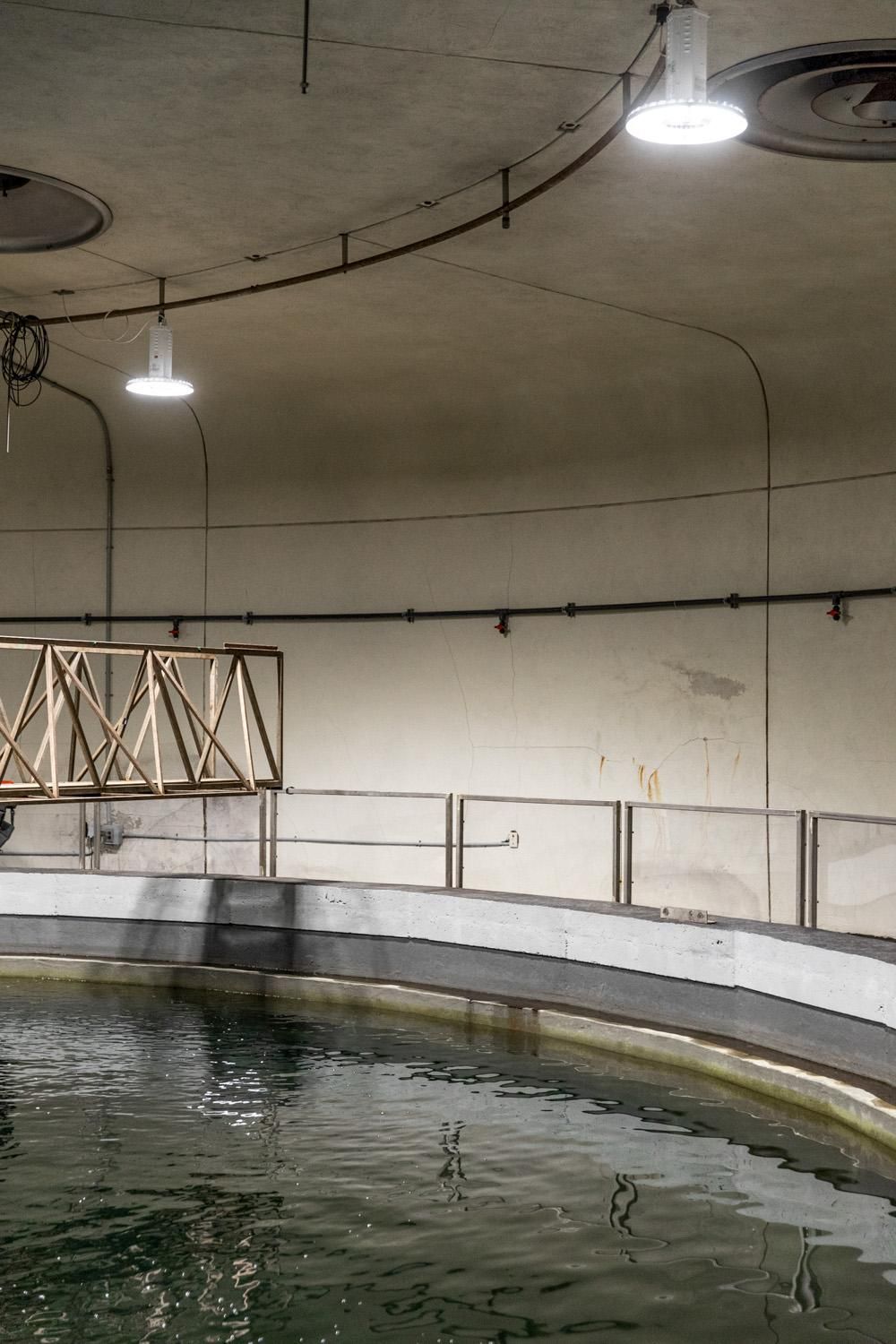
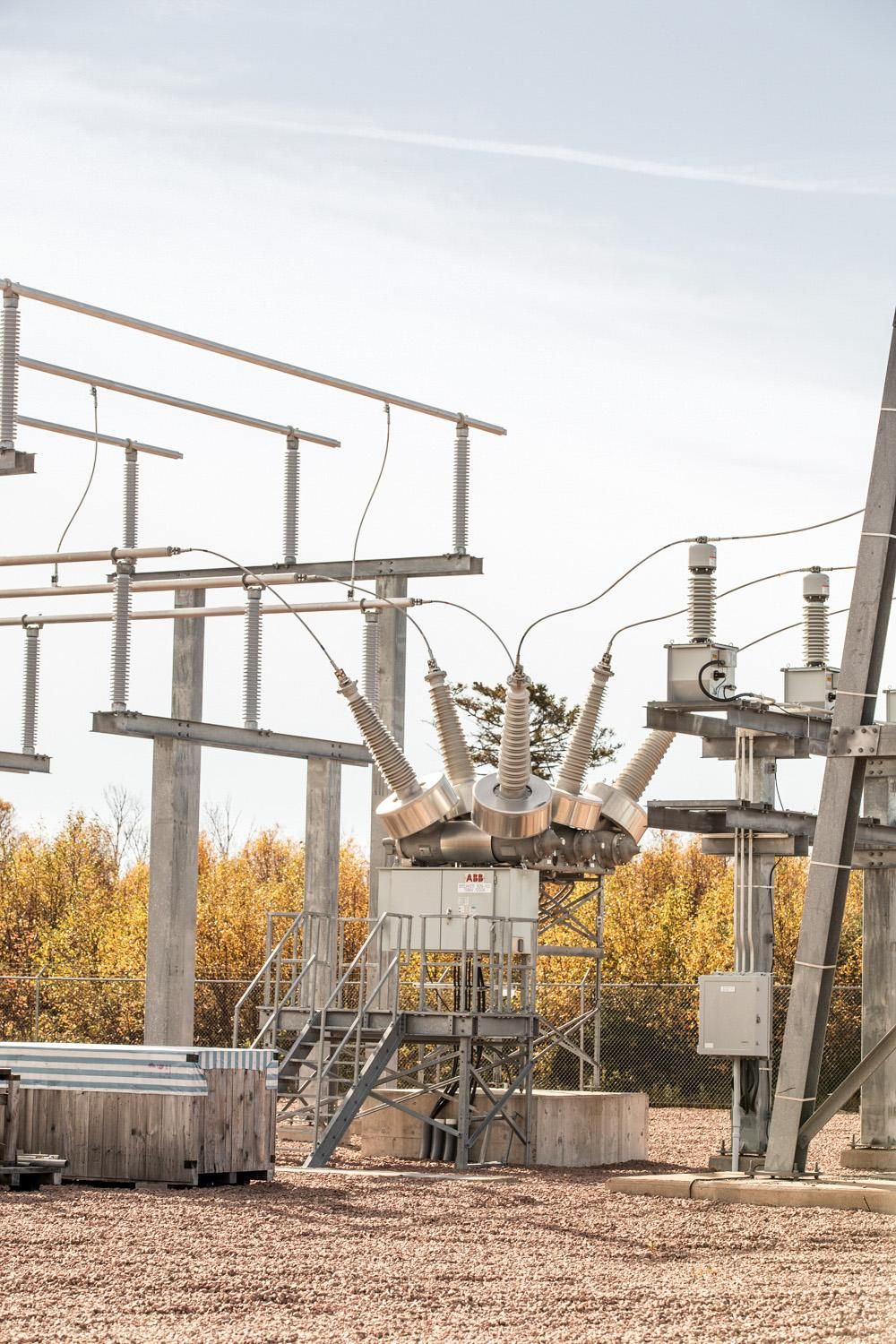
SME first tested the Plat-I in western Scotland’s Connel Sound, then eventually shipped the parts to Nova Scotia, which supported tidal energy projects. The company chose Grand Passage for its New World debut because the channel’s bathymetry is known, the water runs fast and clear, and the site is easily accessed. But Brier Island, population 168, also aligns with Hayman’s broader aim of servicing remote islands and other coastal areas. “The Faroe Islands are a prime candidate for floating tidal,” Hayman says aboard SMEagol. “The Philippines have great currents, British Columbia’s Discovery Passage, the Channel Islands, villages in Indonesia and Korea...” Hayman’s mental globe-spinning may seem grandiose. But wind and solar power also seemed fringy and, to many, a little absurd just two generations ago. Now those technologies are downright mainstream, providing almost a tenth of U.S. power, at competitive prices, and growing fast.
In Grand Passage, SME has demonstrated that a floating platform has major advantages over tidal power’s other main design option—a turbine anchored to the seafloor. Platforms are far cheaper to build and install than bottom-mounted devices (and remove, should things go wrong). And a technician can perform routine maintenance on a platform-mounted turbine during slack tide. “A visit from a lobster boat will do,” Hayman says. Attending to devices on the sea bottom, in comparison, may require a submersible vehicle or a heavy barge with a lifting rig.
With my eye on the yellow fairings that smooth the flow rushing past the Plat-I’s tri-bladed rotors, I ask Hayman if his multimillion-dollar equipment might be in harm’s way. No, he says: Dangerously high currents, ice chunks and debris kick the turbines up and out of the water. And because SME designed the rotors to swing up independently, maintenance can be performed without taking the whole device offline, so it continues to generate revenue.
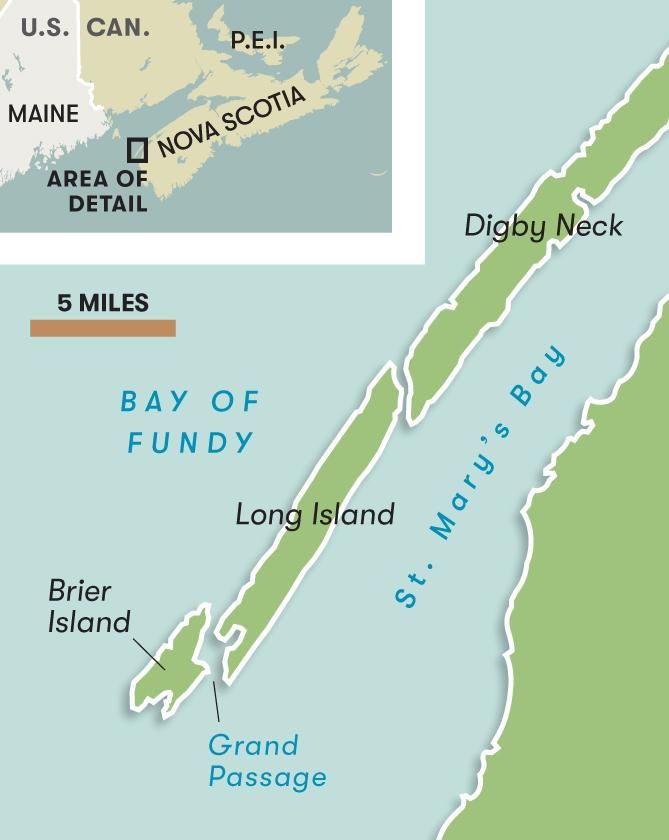
Proponents of in-stream tidal—that is, with turbines located in the water column, not embedded in dams—claim marine mammals and fin fish can easily avoid the blades because nothing impedes the animals’ passage. During a 2017 pilot study that introduced striped bass to a spinning turbine in a circular tank at Dalhousie University in Nova Scotia, fish appeared to avoid the blades, even with the current moving at 3.9 knots. These results “will inform real-world scenarios,” says Sue Molloy, who conducted the study, “and some tests that are done with wild-caught fish will translate very well.”
A study of SeaGen, the world’s first large-scale tidal-stream generator, which operated commercially between 2008 and 2016 in Northern Ireland’s Strangford Lough, suggested that seals avoid moving rotors. In a multiyear pilot study of three riverbed-mounted tidal turbines in New York City’s East River—a demonstration project run by Verdant Power—researchers found no evidence of harm to fish.
Environmental monitoring in Grand Passage, Hayman says, has yielded no evidence that marine animals, save jellyfish, touched Plat’s turbines. Still, as one so often hears when discussing potential environmental impacts, absence of evidence isn’t evidence of absence.
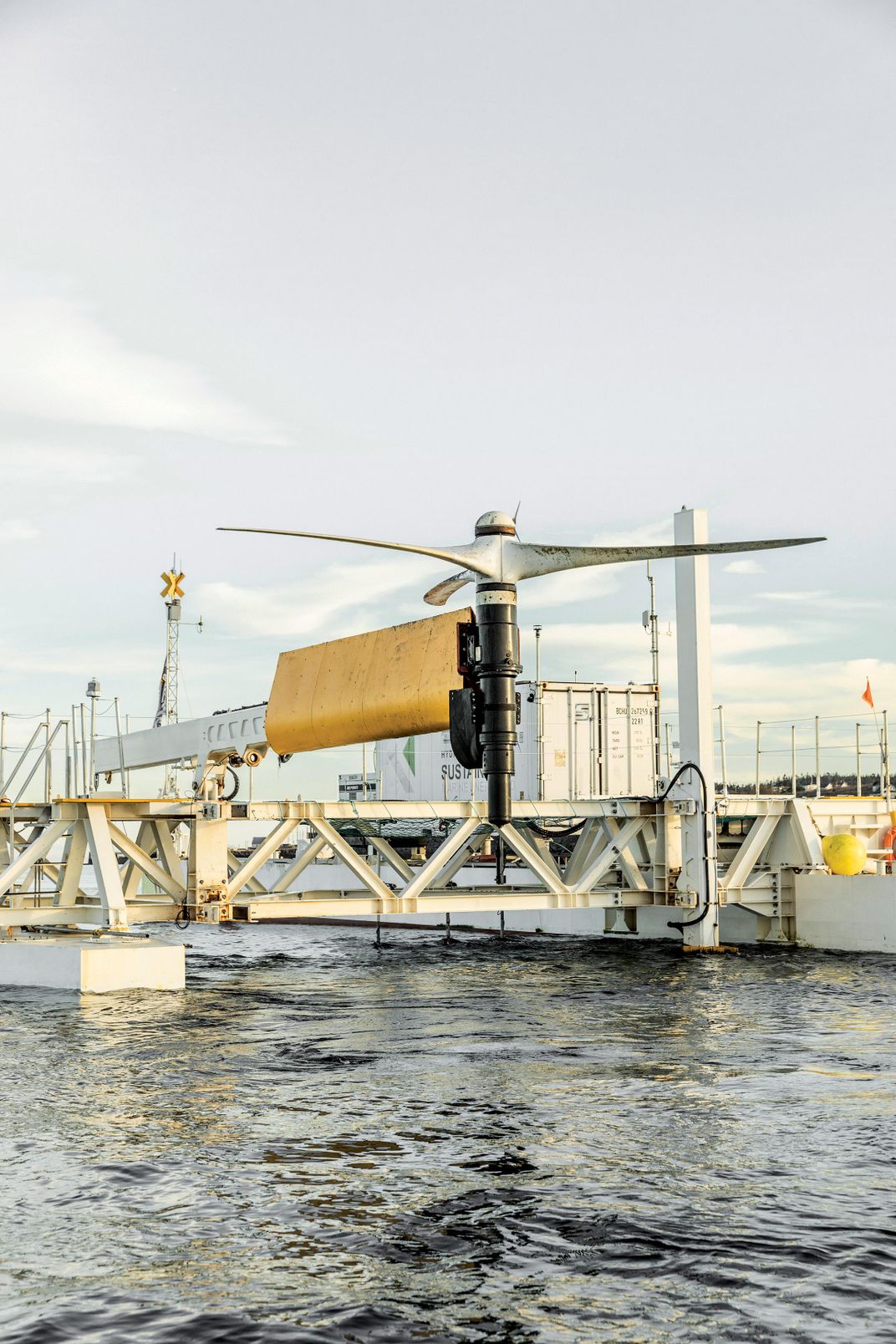
Monitoring the environment around turbines is difficult and expensive. “It’s a highly dynamic environment with lots of turbulence and sediment in the water that hinders visibility,” Anna Redden, a marine ecologist at Acadia University’s Tidal Energy Institute, told me when we met in her office. Air bubbles interfere with acoustic signal detection, as do the engines of seafaring vessels and the whir and blip of other monitoring equipment. Because lights could attract or repel marine life, cameras can record only in daylight hours. Tidal platforms are designed to work in strong currents, but sensors are not. “We’re using off-the-shelf technology that isn’t designed for washing machines.”
I asked Redden what science did know about marine life and turbines. “Nothing for sure,” she said. “And we won’t know if these turbines kill fish until the device is in the water” for a significant amount of time. She paused, then said with a note of tristesse, “There is never zero impact. But what level of impact will we find acceptable?”
* * *
There are tides in tidal power development. Flows correspond with spikes in the price of oil, investor interest and government subsidies that help tidal power compete with wind and solar, which are cheaper. The recent burst of activity in Nova Scotia was sparked by the global climate emergency and Canada’s commitment to reduce greenhouse gas emissions 30 percent by 2030, compared with 2005 levels. (Nova Scotia has already reduced emissions 31 percent, thanks in part to its own wind turbines and to renewable energy imported from Newfoundland, New Brunswick and Quebec.)
But interest in tidal power also ebbs, such as when heralded projects fail. In 2009, Nova Scotia Power partnered with the Dublin-based company OpenHydro to lower a six-story-high, 400-ton circular turbine into Minas Passage. Within days, the current ripped the device apart. In glass-half-full mode, engineers acknowledged they’d underestimated the tide’s force. The company tried again seven years later, with an 1,100-ton model. It generated two megawatts until the company extracted the device for repair and upgrades, seven months into the experiment. In 2018, another turbine was lowered into the passage. But within days, OpenHydro’s investors pulled out, and the company filed for bankruptcy. The turbine rests on the seafloor to this day.
The Fundy Ocean Research Centre for Energy (FORCE), an international test site for tidal-energy development in Parrsboro, Nova Scotia, occupies a glassy building overlooking Minas Passage. Researchers estimate that the waterway’s fast-moving tidal currents could generate 2,500 megawatts—enough to power all of Nova Scotia, home to nearly a million people—and displace up to nine million tons of greenhouse gases. One of the great advantages of tidal power is the density of the kinetic energy itself; a solar-energy project in Morocco that produces 580 megawatts covers as much ground as roughly 3,500 football fields.
Established in 2008 and mostly government-funded, FORCE is the manifestation of Nova Scotia’s tidal dreams; it’s a generator of tidal-energy research and an operations center for companies testing gear and monitoring sea life. But arguably its most important asset lies underwater, where five so-called berths, each just shy of eight acres, await tidal-turbine tenants. Among those expected to plug into FORCE’s submarine cables, which connect to a nearby electrical substation, is SME.
/https://tf-cmsv2-smithsonianmag-media.s3.amazonaws.com/filer/52/fe/52fe8df3-2b7f-4033-960c-d367f7a4057c/apr2020_a02_tidal.jpg)
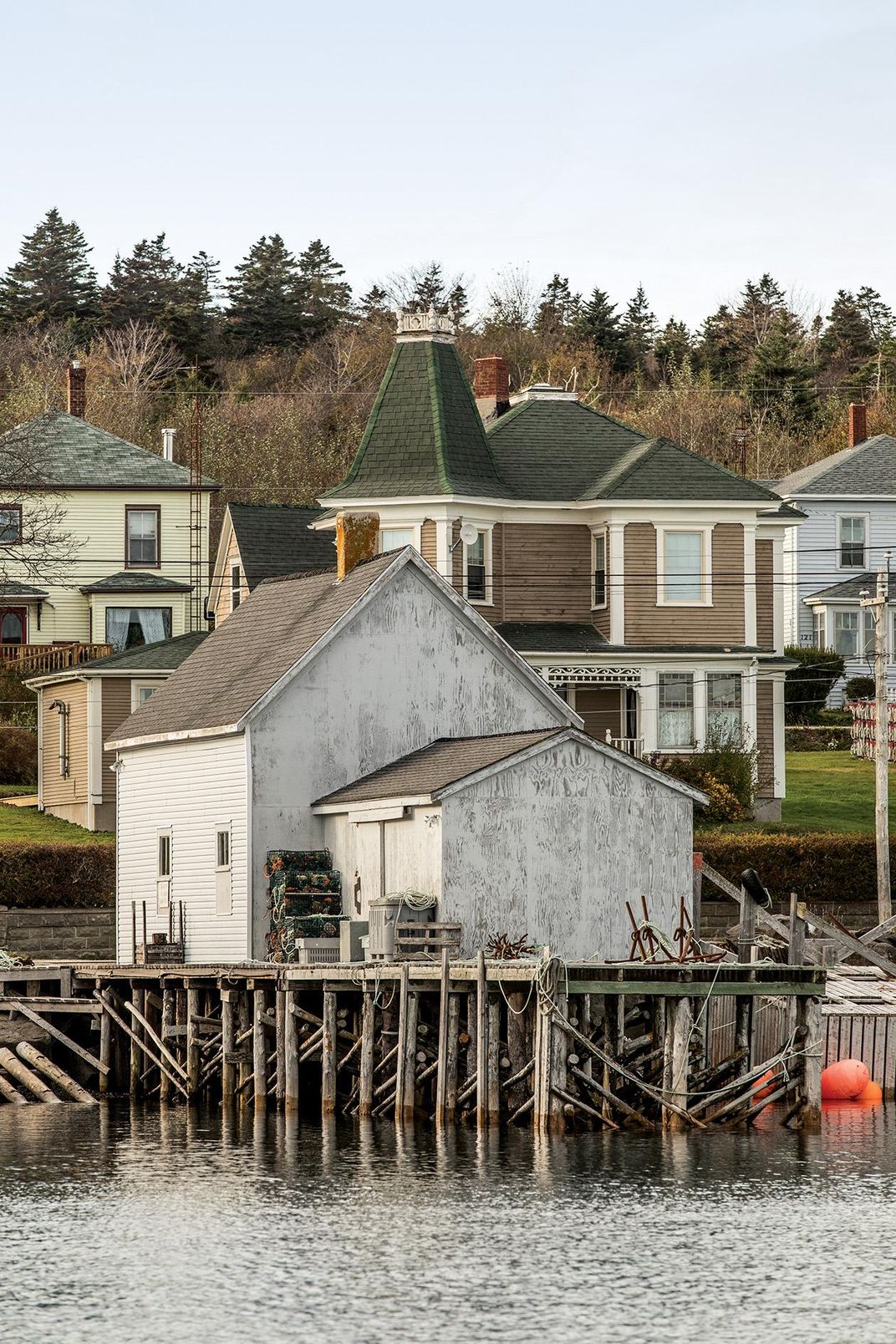
Jason Clarkson had likened the Plat-I to a small turboprop plane. The project that SME hopes to launch in Minas Passage later this year will be more like an Airbus: three platforms, each hosting six turbines. Combined, they will generate 1.26 megawatts. The new venture, a partnership between SME and a Canadian company called Minas Tidal, will be called the “Pempa’q In-Stream Tidal Energy Project.” The word pempa’q means “rising tide” in the local Mi’kmaq language.
From FORCE’s backyard, I scan the silt-rich waters of the passage and focus my binoculars on Cape Split, rising sharply to the southwest. I recall that Nova Scotia had, in an age of ecological innocence (the 1980s), actively considered spanning this waterway with an five-mile-long barrage stuffed with 128 turbines. In comparison, three floating platforms wouldn’t be terribly intrusive. But what about more?
Local fishermen “aren’t worried about one turbine. They are worried about arrays of 300,” Anna Redden, who sits on the board of FORCE, had told me. SME wasn’t the only company prospecting in these currents: FORCE had other tenants moving in, and successful projects always hanker to scale up. “With every doubling of cumulative capacity,” Hayman had told me, “cost to consumers drops by 15 to 20 percent. Pricewise, tidal is where offshore wind was 15 years ago, and solar 10.” If all went well with his three-platform array, he aimed to increase it to 21 and produce almost nine megawatts.
Unlike wind turbines, which have converged on a nearly universal design, tidal turbines still come in many shapes and sizes. Axes of tidal turbines can be vertical or horizontal; the devices resemble tabletop fans, Archimedean screws, the helical blades of push lawn mowers and even wind turbines. (But because water is “approximately 838 times” denser than air, a naval architect can and will tell you, tidal blades can be much smaller than wind blades.) Some turbines operate near the seafloor, others in the middle of the water column or just below the surface. As with any immature technology, projects seem to dip their toes in the water, then retreat for tweaks, a major overhaul, a fresh infusion of cash, or a final journey to the scrap heap.
Down at Brier, the nimble little Plat-I was inching toward the finish line, having avoided so many of those pitfalls. “SME is a success story because they proved they can coexist with fishers, recreational boaters and the ecosystem,” says Terry Thibodeau, the coordinator for renewable energy and climate change at the Municipality of the District of Digby. “They figured out how to moor and pivot their device, and they’ve tested for years.”
If SME’s next generation power plant succeeds in the maw of Minas, one could imagine the company towing parti-colored trimarans to islands and remote coastal sites around the world, fulfilling a particularly satisfying vision of energy independence—one that is hyperlocal, low impact and renewable so long as the Moon continues to circle the Earth.
We won’t know for some time if Hayman will triumph in the Bay of Fundy, but I found myself rooting for this plucky company and its pragmatic leader, who were helping push the world toward a historic moment. In Industrial Age Britain, coal power put water wheels out of business. Now water wheels might help do the same to coal.
*Editor’s Note, March 27, 2020: This story originally stated that tidal energy could generate 12.5 terawatts per year in the United States. In fact, it would generate 12.5 terawatt hours per year.
/https://tf-cmsv2-smithsonianmag-media.s3.amazonaws.com/filer/64/16/64160135-5da1-42db-8e4c-cb6adfd0b4cd/mobile-tides.jpg)
:focal(619x428:620x429)/https://tf-cmsv2-smithsonianmag-media.s3.amazonaws.com/filer/13/66/1366c7f3-b79c-431a-ad71-4909eca768aa/tides-opener-desktop.jpg)